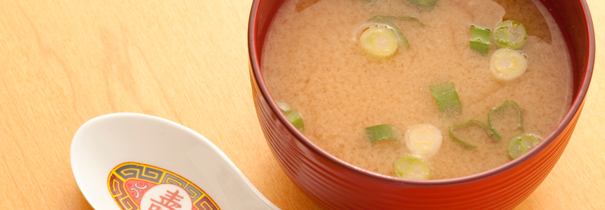
What we've been up to
Japanese Miso Soup
 Each region of Japan has its own type of miso according to the area's climate and eating customs. The three main types of Miso soup can be best identified by their difference in colour. Shiromiso is a white miso made from rice native to Kyoto, hatchomiso , a sweet soybean miso particular to Aichi Prefecture, and Shinshu, the most widely eaten miso, is a salty, red-coloured paste, produced chiefly in Nagano Prefecture.
Each region of Japan has its own type of miso according to the area's climate and eating customs. The three main types of Miso soup can be best identified by their difference in colour. Shiromiso is a white miso made from rice native to Kyoto, hatchomiso , a sweet soybean miso particular to Aichi Prefecture, and Shinshu, the most widely eaten miso, is a salty, red-coloured paste, produced chiefly in Nagano Prefecture.Miso Soup is not only deliciously tasty, but it also contains various health benefits. As they say in Japan, a bowl of miso a day keeps the doctor away! Vitamin E, daisein, saponin and the brown pigment contained in miso act as anti-oxidants. Miso is also a source of dietary fibre, which cleans your intestines and is good for your bowel and this is just to name a few.
Miso soup is quick and easy to cook with Asian Home Gourmet's Japanese miso spice paste sachet. Here are some secrets behind the simplicity, just as with cooking other Japanese dishes:
• Avoid leaving miso soup overnight, because "fresh" miso soup is definitely the best
• Make sure to serve miso soup hot
• If the package has not been opened, miso can be preserved at room temperature
• Once you use miso, keep it in a refrigerator and seal the package with plastic wrap
Miso Soup
Serves 4
· 1 packet Japanese Miso Spice Paste
· 150 g (5.25 oz) silken tofu; cut into small cubes
· 500 mL - 605 mL) (2½ - 2¾ cups ) water or unsalted chicken stock
· Fresh spring onions, chopped as garnish
1. Mix Spice Paste and water in a saucepan.
2. Bring the mixture to boil. Stir occasionally.
3. Add tofu and cook for 1 minute. Garnish.
Cooking tips:
(a) Meat or seafood may be used instead of tofu. Adjust cooking time accordingly.
(b) Miso Stir-Fried Seafood/Meat
Heat 1 tbsp oil in non-stick pan. Add 550 g (2¼ lb) seafood (scallops or
prawns) or sliced chicken meat; stir-fry for 5 minutes. Add Spice Paste and 100 g (3.5 oz) vegetables
(onion or carrots), stir-fry until cooked.
Recently:

Indian Korma
The roots of Korma can be traced back to the Mughali era. Like most dishes with a rich heritage, cooking techniques vary over time as methods and secrets are passed down through the generations. Today, Korma is a mild, creamy aromatic base, in which vegetables or meats are simmered. Cream and coconut milk are the base of the sauce with subtle aromatic spices such as cardamom cloves and cinnamon.

Indonesian Rendang
Rendang originated in Indonesia from the Minangkabau. It is traditionally made with beef but it can also be made with chicken, lamb, duck or vegetables, and is prepared by slow cooking in coconut milk. Rendang contains four basic ingredients, each with its own symbolic significance. A mix of rich, cultural heritage and famous tropical spices has created the legendary, dish of rendang.

Singapore Laksa
Singapore Laksa, commonly referred to as Curry Laksa, is generally thin vermicelli rice noodles (bee hoon) and bean sprouts topped with a sliced boiled egg, prawns or chicken, fish cake, beancurd puffs and cockles, and served in a rich coconut-based curry broth. The key ingredient giving Laksa its unique flavour and aroma is the Laksa leaf (also known as Vietnamese mint).

Pad Thai
Pad Thai is generally the first dish that pops into one's mind when they are thinking of Thai Cuisine. A Pad Thai dish is the ideal blend of sweet, salty and sour. There are an infinite number of variations on this timeless tradition, but usually noodles are dressed up with bean sprouts, onion, tofu and the brilliant final touch: peanuts ground to near dust.

Japanese Miso Soup
Each region of Japan has its own type of miso according to the area's climate and eating customs. The three main types of Miso soup can be best identified by their difference in colour. Shiromiso is a white miso made from rice native to Kyoto, hatchomiso , a sweet soybean miso particular to Aichi Prefecture, and Shinshu, the most widely eaten miso, is a salty, red-coloured paste, produced chiefly in Nagano Prefecture.